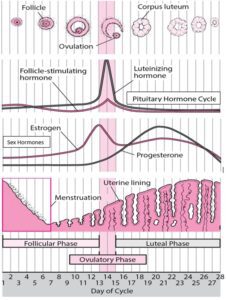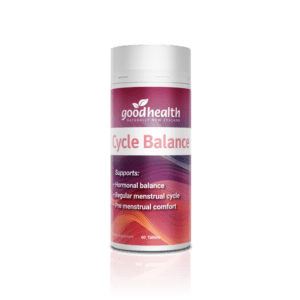
为了庆祝我们的女性健康系列的发布,Good Health 自然疗法团队撰写了一系列健康文章,深入探讨初潮、月经和更年期这三位女士的奇妙而复杂的世界。我们还将探讨女性荷尔蒙生命周期和微生物群、可能出现的潜在问题、发生了什么以及发生在哪里,以及如何支持女性特有的一些祖传秘方。
第 2 部分 - 月经
在大多数社会中,月经被认为是一个禁忌话题,妇女会因此而感到肮脏甚至危险,这一点很难被忽视。原始的观念包括对细菌传播的焦虑,以及对血腥味影响动物狩猎的担忧。在那个时代,尊重女性的传统文化少之又少。在西方,我们已经取得了长足的进步,但仍有一种观念认为女性在月经前或月经期间不那么 "可靠 "和 "易变",这并不是一种特别准确或有成效的模式。
还有一种观点认为,住得近的妇女往往会彼此同步,每月在同一时间来月经。无论这是否是一种真实的现象,一些文化选择在月经前后举行仪式,将这段时间描述为具有更高的灵性和联系。无论你对自己的月经周期有什么看法,重要的是要知道发生了什么--什么应该发生,什么不应该发生--这样你才能有能力照顾好自己的健康,知道什么时候应该寻求专业建议,并学会把它当作一件非常特殊和独特的事情来对待。

主要生殖激素和周期
生殖激素是类固醇激素和 孕烯醇酮 是所有生殖激素的胆固醇前体。
> 雌激素 雌激素不是一种单一的激素,而是一组激素,即雌激素。雌激素是通过性腺(卵巢)、大脑、脂肪组织、胎盘、血管、皮肤、骨骼和肾上腺等不同组织中的芳香化酶(雌激素合成酶)使雄激素芳香化而产生的。雌激素在不同程度上刺激乳腺和生殖器官的发育,并确保其功能。雌激素的主要功能是刺激组织生长,但其作用方式必须严格控制。
三种主要形式是 雌二醇(E2)这是卵巢、肾上腺和脂肪细胞在年老时制造的最有效的形式; 雌酮 (E1)雌酮是绝经后的主要雌激素,主要由脂肪细胞和肾上腺产生(在生育期,卵巢会产生一些雌酮);以及 Oestriol (E3)E4是雌激素中最弱、活性最低的一种,主要在怀孕期间发挥作用。另一种雌激素称为雌二醇(E4),只在怀孕期间产生。
通过肝脏代谢的雌激素主要有三种:2-羟基雌酮(2-OHE1)、16-羟基雌酮(16-OHE1)和 4-羟基雌酮(4-OHE1)。2-OHE1 被认为是最安全、最弱的代谢物。4-OHE1 和 16-OHE1 要强得多,而且与生殖组织和大脑的损伤有关。不良饮食习惯、饮酒、使用杀虫剂、吸烟、肥胖等与循环中 4-OHE1 和 16-OHE1 水平较高有关。
> 孕酮 黄体酮通常被认为是第二重要的 "女性荷尔蒙",但它的意义远不止于此。孕酮主要由卵巢制造,但肾上腺、外周神经和脑细胞也有贡献。孕酮确保乳房和女性生殖道的发育和功能。它有助于刺激子宫内膜的生长。在大脑中,黄体酮具有镇静作用并有助于睡眠。黄体酮有助于胰岛素敏感性、新陈代谢、甲状腺激素功能、骨骼生长、心血管系统和性欲。黄体酮能拮抗雌激素(和皮质醇),使其处于受控状态,尤其是在怀孕期间。
> 令人惊讶的是,雄性激素 睾酮荷尔蒙是女性体内最丰富的生殖激素,但男性的含量要高得多。它支持性欲、睡眠、心脏和大脑功能;强化韧带;增强肌肉和骨骼;与自信和耐力有关。
> 去氢表雄酮 (DHEA)主要由卵巢和肾上腺分泌,但皮肤和大脑也会分泌。DHEA 是最丰富的循环荷尔蒙,它能抵御压力效应,支持性欲、动力、免疫健康、睡眠和头脑清醒。DHEA 可在脂肪、肌肉、骨骼和肝脏组织中转化为雌激素和睾酮。
简单地说 月经周期 是由下丘脑-垂体-性腺轴(HPG)和激素调节的。 瘦素.在大脑中,下丘脑会释放 促性腺激素释放激素 (GnRH)进入垂体前叶,导致促性腺激素的产生和分泌,包括 促黄体激素 (LH) 和 卵泡刺激素 (FSH)。LH 和 FSH 作用于女性性腺(卵巢),刺激排卵(LH)并将卵巢中的雄激素转化为雌二醇(FSH)。
顺便提一下,男性和女性产生相同的荷尔蒙,但其产生部位、组织和血液浓度以及与器官系统的相互作用却不同。
女性月经周期
女性的月经周期(见图)是垂体和卵巢激素影响卵巢、子宫和乳房生殖组织生长或分解的一连串过程。整个周期的持续时间通常为 28 天左右,但也可能在 21-35 天之间变化,这被认为是 "正常的"。周期从月经的第一天--经期开始,到月经的前一天结束。
在生理周期的中期,即排卵期,卵泡会排出一个卵子。有时会排出不止一个卵子。排卵后,成熟的卵子可以在性交过程中与精子受精,这通常会导致受孕和怀孕。如果卵子仍未受精,它仍会进入子宫,在那里子宫内膜会在 21 天左右的时间里逐渐形成。月经就是未受精卵和多余的子宫内膜组织一起脱落。
图形 - 月经周期

如何知道自己是否排卵?
您可以寻找和测量一些迹象:
- 基础体温 (BBT) 的变化 - 您的 BBT 最低 每日 您可以在每天早上醒来时测量体温。在排卵后的第二天,您的 BBT 会升高(可能在略微下降后),大约在 0.22 到 0.56 摄氏度之间,并一直升高到月经来潮。您最易受孕的时期是 BBT 升高前的两到三天。您需要一个特殊的基础体温计,大多数药店都有出售,您可以通过绘制几个月的月体温变化图来找出规律。
- 宫颈粘液的变化:排卵前 5-6 天和排卵后 2-3 天,您可能会注意到宫颈粘液的增加和变化。为了帮助精子游向卵子,这种粘液会变得像生鸡蛋清一样--有弹性、透明、稀薄、滑溜。当粘液最滑、最清澈时,受孕的可能性最大。
- 子宫颈的变化:如果您处于排卵期,您的子宫颈会比平时更软、更高、更湿润、更开放。您的阴唇可能会轻微肿胀并更加敏感。
- 下腹或背部/侧面不适:这被称为 锚 (德语为 "中间痛")。这种感觉可能持续几分钟到一天左右,可能是钝痛,也可能是剧痛。
- 斑点:浅棕色或红色斑点可能一次出现,也可能持续几天,这是卵泡裂开释放卵子的结果。
- 乳房胀痛:排卵后,荷尔蒙的释放可能会让你的乳房或乳头感到胀痛和沉重。
- 嗅觉增强:一些女性报告有此现象,但还需要更多的研究。
- 性欲增强:有道理!这是生育的 "最佳 "时间。
- 食欲或情绪变化:由于排卵时雌激素水平达到峰值,您的食欲可能会下降几天。然后,随着月经(或怀孕)前孕酮的上升,你的食欲可能会增加。排卵期间释放的促性腺激素和促性腺激素可能有助于保持良好的情绪。
- 体液潴留:排卵前 LH 和雌激素上升可能会导致体液潴留和腹胀。然后,随着孕酮的增加,你的消化可能会减慢。
如果不排卵,就没有卵子可用,也就无法怀孕。这就是所谓的无排卵周期。如果您真的怀孕了、绝经后或正在避孕,您也不会排卵(至少您不应该排卵!)。如果您正在服用某些药物、刚分娩过(尤其是纯母乳喂养)、生殖激素失调、体重过轻或过重,和/或压力过大,也可能无法怀孕。压力会破坏你的荷尔蒙和生殖周期。
生殖问题
在中国传统习俗中,妇女在月经周期的任何阶段出现任何问题都被认为是不正常的;妇女的月经应该像太阳升起和落下一样来去自如。月经前应几乎没有情绪波动、烦躁、疼痛、点滴出血、乳房或腹部不适、皮肤破损或消化不良等症状,月经期应舒适,几乎没有血块,持续时间不超过 5-6 天。月经应该相对规律,尽可能接近 28 天的周期。每个月都应该排卵,不应该有不规则或过多的出血,也不应该完全没有月经。 如果您对自己的生理周期有任何担心,请去看专业医生。
健康的育龄妇女是能生育的妇女。这并不是说不健康的女性就不能怀孕,但我们可以从女性的月经周期看出她的真实健康状况。她可能真的有生育能力,也可能没有排卵,但往往会有一些迹象表明她的身体出现了失衡或功能障碍。
压力是影响生殖激素平衡的一个大问题,因为当我们压力过大时,我们的身体会将生殖等 "非必要 "功能列为优先事项,氧化过程也会失控。研究表明,持续的情绪压力会降低生殖激素的分泌和/或使其失去平衡。猖獗的氧化会导致或加剧生殖和荷尔蒙问题。研究还表明,生殖激素的健康在很大程度上受昼夜节律--每天自然的光暗周期--及其主要激素褪黑激素、皮质醇和瘦素的影响。瘦素是一种对生殖健康极其重要的激素,昼夜节律紊乱会使瘦素失调,并对身体造成重大压力。

在世界上血糖失调和新陈代谢功能障碍发生率较高的地区,不孕症十分普遍。在西方国家,尤其是美国,只有不到 15% 的人口被认为是代谢健康的。代谢功能障碍会影响生殖生理,包括卵子(卵细胞)的发育、排卵和着床。排卵和月经不调、睾丸激素失衡的迹象以及发育异常被认为可能是由于芳香化酶的代谢抑制导致雌二醇减少引起的;然而,这其中涉及多种因素,如果雌激素不能通过肝脏和肠道正常代谢和排泄,或者黄体酮分泌过少,雌激素也会肆虐!
荷尔蒙平衡
健康的肝脏对生殖激素的代谢和管理至关重要。肝脏的健康受到人体新陈代谢健康的影响。有研究表明,在新陈代谢失调和肝功能不健康的模型中,高浓度或再循环的雌激素可以刺激肾上腺,而不涉及垂体,从而导致肾上腺雄激素增加,体毛生长和其他男性特征增加。雌激素(此时主要是雌二醇)需要在适当的时候产生、发挥作用,然后 "离开道奇"。没有出现问题的女性能够将雌二醇代谢为 2-羟基雌酮(2-OHE1)并排出体外。循环或过量的雌激素及其不太健康的代谢产物 16- 羟基雌酮(16-OHE1)和 4- 羟基雌酮(4-OHE1),和/或相对较低的孕酮,通常被称为 "雌激素优势"。这会导致月经周期出现一系列问题,包括经前问题。血清素及其相关激素的失衡也会造成问题,尤其是在月经来潮前。此外,甲状腺的健康也会影响生殖功能和新陈代谢。支持肝脏和甲状腺健康的营养素包括动物蛋白、胆碱、铜、碘、硒、锌以及维生素 B1、B3、B6、A、D3 和叶酸。碘对所有生殖组织的健康尤为重要,而真正的维生素 A(视黄醇)对生殖功能至关重要。参见 肝爱让生活更美好 了解更多有关肝脏健康的信息。
产生适量的雌激素并通过肝脏和肠道迅速代谢和排泄是非常重要的,除此之外,确保孕酮的健康分泌似乎也同样重要。在压力大的时候,孕酮的合成会受到抑制,以防止怀孕,因为生殖并不被认为是一种急性的、生死攸关的活动,不像遇到威胁时的奔跑或搏斗。雌激素和/或其代谢物过高、自由基过多、催乳素和促肾上腺皮质激素水平过高、皮质醇过高、胡萝卜素水平过高以及促性腺激素失衡都会导致孕酮过低。甲状腺激素和低密度脂蛋白过低,以及真正的维生素 A(视黄醇)缺乏症,也会阻碍孕酮的合成,某些导致青春期提前的因素也会阻碍孕酮的合成(请参阅 "青春期提前")。 初潮文章 在本系列中)。雌激素会诱发脑细胞兴奋性中毒死亡,而孕酮和孕烯醇酮可以消除这种现象以及其他未受控制的雌激素造成的后果。
虽然我们无法理解人体荷尔蒙和新陈代谢功能的真正复杂性,虽然科学研究,尤其是对女性内分泌(荷尔蒙)功能的研究还很缺乏,但我们可以利用我们相对有限的知识将许多问题联系起来。我们的现代生活方式--高脂肪、超加工食品饮食、高压力、暴露于污染、化学物质和人造光(尤其是在夜间)--很可能是导致荷尔蒙失调和生殖问题高发的罪魁祸首。研究表明,蓝光照射、化学和空气污染、饮酒、中心性肥胖、肥胖、炎症、食用精制糖和种子/植物油、药物、营养素缺乏等,都会导致或加剧严重的代谢功能障碍,对肝脏健康(和其他器官)造成负面影响,并对生殖和荷尔蒙产生下游效应。荷尔蒙平衡简单地说就是荷尔蒙与其他荷尔蒙的比例正确,这样生殖系统和整个身体才能发挥其应有的功能。
人类祖先的智慧
全球各地有一些 "原始 "人类,他们仍然生活在大自然的怀抱中,他们的妇女没有出现生殖问题。据推测,这是因为他们拥有健康的新陈代谢,这与进化过程中祖先的生活方式是一致的。

主要因素似乎是
- 营养丰富、以动物性食物为主的饮食,不食用超级加工食品
- 健康平衡的微生物群
- 与大地、自然和彼此的深厚联系
- 支持性社会网络
- 适当的活动量
- 几乎没有电磁、化学或空气污染
- 减轻总体压力
- 享受创造和学习
- 无药物治疗
- 每天接触自然光(几乎没有人造光--LED/荧光灯、屏幕等)
科学研究表明,这些生活方式有助于调节人体昼夜节律、平衡荷尔蒙功能、酣睡、压力管理、氧化还原潜力(健康氧化和减少自由基积累),以及自然产生大量 "感觉良好 "的荷尔蒙。
如果你是处于人生任何阶段的女性,并且正在经历生殖荷尔蒙失衡,从而影响你的生活质量,你可以阅读更多有关祖传生活方式和饮食因素的信息,以支持你的荷尔蒙和新陈代谢、 这里.
草药在传统医学中有着悠久的使用历史,对女性荷尔蒙有很好的支持作用。
介绍: 良好的健康周期平衡
良好的健康周期平衡 是一种独特的混合物,由 6 种经过科学研究剂量的协同草药和海带(含碘)组成,旨在支持健康的月经周期、平衡的荷尔蒙以及经前和经期的舒适感。在中国传统习俗中,育龄妇女长期以来一直使用当归、柴胡、芍药、生姜和甘草,研究表明,它们有助于健康的荷尔蒙平衡、血流量、子宫张力、经期舒适度和肝功能。健康的肝脏对支持雌激素的新陈代谢至关重要。周期平衡配方支持神经和荷尔蒙系统,促进健康的情绪、皮肤和乳房舒适度。甲状腺和肾上腺也能得到支持,因为它们对健康的生殖功能至关重要。

周期平衡支持:
- 荷尔蒙平衡
- 经期的舒适性
- 调节经期规律性
- 经前和乳房舒适
- 健康的血液流动
- 肝脏、甲状腺和肾上腺功能
- 健康的情绪和皮肤
点击以下链接,了解更多女性健康系列内容:
TAPS 编号:PP2522 和 PP2888
